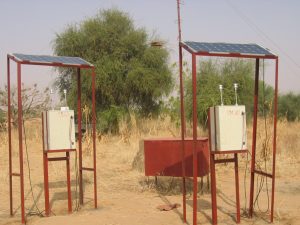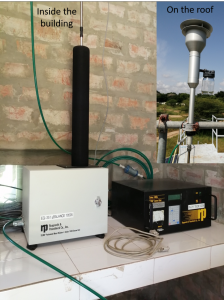PM2.5 and PM10 aerosols chemical characterization
Aerosols samples are collected with two automatic aerosol samplers designed and developed for the INDAAF program (Ouafo-Leumbe et al., 2018). Each sampler is equipped with two independent air inlet pumps connected each one at an online NILU filter holder. This latter is surmounted with a sampling head corresponding to an aerodynamic particles diameter (PM2.5 & PM10). Two Mini Partisol low air inlets (Rupprecht and Patashnick) operate at a flow rate of 5 L min-1 and the air volume sample is measured with a precision of ± 0.01 using a gas meter.
Sampling of PM10 and PM2.5 aerosols are collected on quartz fiber filters (Whatman QMA, 47 mm diameter and 0.5 µm of porosity) to determine particulate carbon and on Teflon filters (Pall Zefluor, 47 mm diameter and 0.5 µm of porosity) intended for analysis of major ions.
Quartz fiber filters ae cleaned by burning at 450°C for 48h before exposition. Teflon filters are weighed before exposition using a SARTORIUS MC21S microbalance (1 µg resolution for a maximum range of 21 g- Measuring accuracy of ± 5 µg).
After collection and before analysis, samples and blanks filters are conditioned in petri slides boxes which are stored at 4°C. Integrated PM2.5 and PM10 weekly filters samples are analyzed at the Laboratory of Aerology (LAERO) using thermo-optical analysis (EUSAAR2 method) and Ionic Chromatography (IC).

PM10 concentration

Atmospheric concentrations of Particulate Matter smaller than 10 µm (PM10) are measured using a Tapered Element Oscillating Microbalance (TEOMTM 1400A from Thermo ScientificTM) equipped with a PM10 inlet (Thermo ScientificTM). The concentrations in micrograms per cubic meter (µg m-3) are recorded as 5 min averages and distributed as 1 hour averages (UTC).
Aerosol Optical Depth

Aerosol Optical Depth (AOD) is measured using a CIMEL sunphotometer. The sunphotometers deployed in the INDAAF stations are part of the international AErosol RObotic NETwork (AERONET). They are managed by the French branch of the AERONET, PHOTONS (PHOtométrie pour le Traitement Opérationnel de Normalisation Satellitaire).
Data can be downloaded via the AERONET Data Display Interface.
References
Ouafo-Leumbe, M.R., Galy-Lacaux, C., Liousse, C., Pont, V., Akpo, A., Doumbia, T., Gardrat, E., Zouiten, C., Sigha-Nkamdjou, L., Edkodeck, G.E., 2018. Chemical composition and sources of atmospheric aerosols at Djougou (Benin). Meteorol. Atmos. Phys. 130, 591–609. https://doi.org/10.1007/s00703-017-0538-5
